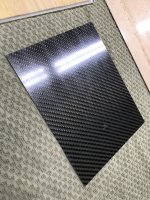Been doing some experiments with vacuum bagging trying to make a small e-glass/nomex plate.
Actually the process was easier than expected when it comes to doing the actual work, but made a couple of mistakes in the process, so haven't made a perfect plate yet.
First try I simply did the layup on the glass with some hairspray as release agent which I seen should be possible alternative. Maybe for some jobs, but not for a thin fragile plate like this, and I had to scrape it off in pieces.
Second attempt I used bagging plastic at the bottom, which worked and gave a useable plate. Unfortunately the scale I used for measuring resin and hardener misbehaved so I didn't get an accurate mix. Also the first attempt was hardened during daytime when the workspace I use is much warmer, but this mostly during the night. So it was not hardened enough when I took it out so delaminated a bit. Also since laying it up on the plastic, neither side became really flat and dented in a bit in the honeycomb cells.
So I made another attempt this time with an accurate scale, using silicone spray as release agent and giving it proper curing time. It worked better than with the hairspray, but still bonded to well to the glass to get the plate demoulded without damage. Bottom surface did look very good though.
So I clearly need to get a teflon surface to work on, or get a proper release wax.
I did test the second attempt which has some delamination around the edges on one side, but still was the best of the tests, and results was not impressive. Certainly nowhere near the sensitivity of EPS anyway. While the plate is small and imperfect, I think I can conclude that e-glass on nomex core is not a great material.
It does have a cool look and one could also colour the resin with pigments, and maybe with a well produced plate it can sound good, but still quite much work and cost for a low sensitivity material, so don't think I will explore it further.
Due to the time constraints I'll probably I'll go with EPS for now, and take my time and see if it will be worthwhile to upgrade to carbon/nomex for next year.
Actually the process was easier than expected when it comes to doing the actual work, but made a couple of mistakes in the process, so haven't made a perfect plate yet.
First try I simply did the layup on the glass with some hairspray as release agent which I seen should be possible alternative. Maybe for some jobs, but not for a thin fragile plate like this, and I had to scrape it off in pieces.
Second attempt I used bagging plastic at the bottom, which worked and gave a useable plate. Unfortunately the scale I used for measuring resin and hardener misbehaved so I didn't get an accurate mix. Also the first attempt was hardened during daytime when the workspace I use is much warmer, but this mostly during the night. So it was not hardened enough when I took it out so delaminated a bit. Also since laying it up on the plastic, neither side became really flat and dented in a bit in the honeycomb cells.
So I made another attempt this time with an accurate scale, using silicone spray as release agent and giving it proper curing time. It worked better than with the hairspray, but still bonded to well to the glass to get the plate demoulded without damage. Bottom surface did look very good though.
So I clearly need to get a teflon surface to work on, or get a proper release wax.
I did test the second attempt which has some delamination around the edges on one side, but still was the best of the tests, and results was not impressive. Certainly nowhere near the sensitivity of EPS anyway. While the plate is small and imperfect, I think I can conclude that e-glass on nomex core is not a great material.
It does have a cool look and one could also colour the resin with pigments, and maybe with a well produced plate it can sound good, but still quite much work and cost for a low sensitivity material, so don't think I will explore it further.
Due to the time constraints I'll probably I'll go with EPS for now, and take my time and see if it will be worthwhile to upgrade to carbon/nomex for next year.
Thanks for the tip, looks very interesting. Will be expensive though...checked their site, and with the double frame construction I been thinking it works out close to €1000 per stack, so €4000 in total for the system. Not that much when it comes to pro-audio, but a lot for me :\You might consider MakerBeam XL framing. It lets you make sturdy nice looking frames quickly. I use it to make amp chassis quickly. My griddle amp:
View attachment 1064243
Maybe you don’t need a double stack. Think of the rail as a place to put smaller clamp blocks comprised of a bolt and two smaller pieces of aluminum with a foam spacer.
Hello Eucy,Questions on Aesthetics/Finishing/Design
Looking through the DML posts I see a predominance of material experimentation and testing (which is in accordance with the topic of this thread), but relatively little of finished projects and it prompts me to ask the following questions:
1/ When considering and developing a project, how much of the thought process and effort is directed at producing a finished item with aesthetics and finish quality you would be pleased to display in a living room (whilst not compromising acoustic performance) ?
2/ If aesthetics and design are priority aims, to what extent, if any, do members feel limited by build experience, materials, and equipment/tools to achieve the desired ends?
3/ If limited in any of the above aspects, what, if any, practical things could possibly be done to assist/improve results?
4/ How many members have been satisfied/dissatisfied with finished projects from an aesthetic viewpoint ?
5/ How many don't care what a project looks like as long as it sounds great ?
Cheers
Eucy
Aesthetics, finishing are elements of my "specifications" as the goal is to have at the end something sitting in our living room, that my wife will be also pleased to listen to with a style that fits with our home.
I started tests with XPS but the difficulty or at least the uncertainty of the result after testing some paint, it lead me to make tests with plywood as we like wood finishing objects.
If you go back in the posts, you will see in the pictures of my plywood DML some tentative in this direction... of course a matter of taste.
For them for example, the reaction of my wife is more to say their dimensions is not adapted to the room they are for now, but it is in the good way from a styling and finishing point of view... from a listening point of view also.
I made also canvas DML without any finishing... nice enough to be in another room.
For test purposes I used some XPS but not with intention to have it in a finished design. It was more an opportunity of available material.
Currently, I am wondering what would be the alternative to plywood (too heavy, too stiff) with wood (balsa?) as external visible layer.
If you go back to previous other realizations (see link for example in the history file I posted), there are some nice realizations.
I follow you on the fact there is almost no describing a realization from A to Z... but how many DML builders in the world?
Christian
Eucy,Questions on Aesthetics/Finishing/Design
You raise a good point. Compared to the other sections of this forum, there are indeed relatively few examples of "pretty" DML speakers.
I consider myself to be still in the stage of understanding what it takes to achieve the acoustic performance that I seek, so that remains my primary objective at the present time. In the end, however, I do want to come up with designs that sound great, and look great too. So while I am mostly concentrating on a design that sounds good, I have also put a fair amount of thought and effort into making nice looking speakers too.
Below is a pic of the first DML speaker I made with aesthetics in mind. The panel is cheap plywood but it has a nice veneer on the face, so turned out pretty good. Good enough at least that this speaker (and it's pair) have been permitted to occupy the main living area for some time.
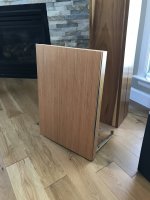
The panels and frames below were intended to replace the speaker above. The plates are carbon fiber (over balsa). The frames are poplar, and I routed the face of the frame so that the face of the panel would be flush with the face of the frame. Both panels have a glossy spread tow carbon on the face, and a matte twill weave on the back. But either the glossy or matte sides could make an attractive panel, depending on the look you are going for. Sadly, I never completed the assembly of this pair. Before they were finished I decided that high aspect ratio panels offered the possibility of flatter frequency response, so this project was set aside, incomplete.
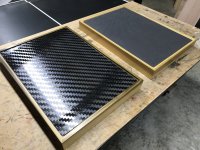
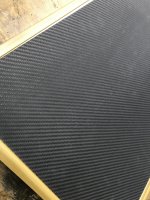
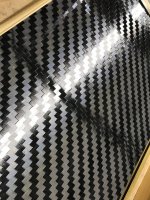
The pair below are prototypes of the high aspect ratio type. These were never intended for "looks", but I think they look pretty good anyway.
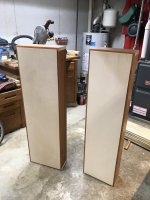
I think composites offer a lot of nice aesthetic possibilities (along with good efficiency).
Below are some examples of test panels made with carbon fiber or fiberglass over balsa. The long skinny one on the right of the last image is my latest panel. Fresh from the vacuum bag just this morning. I like the look of CF, but the balsa showing through the fiberglass is a pretty good look too, I think.
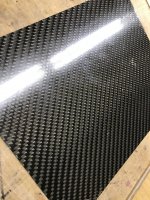
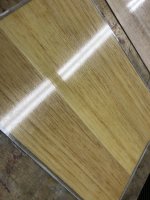
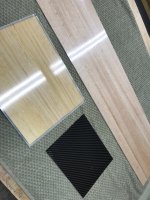
For me, the aesthetics are almost (but not quite) as important as the sound.
Eric
Attachments
Leob,Been doing some experiments with vacuum bagging trying to make a small e-glass/nomex plate.
Actually the process was easier than expected when it comes to doing the actual work, but made a couple of mistakes in the process, so haven't made a perfect plate yet.
Thanks for sharing your experience. I also recently tried a small fiberglass/nomex plate and didn't do any better than you. My bag wouldn't hold vacuum, so I just stacked up a plate with weights on top during the cure. Because of that, or maybe not enough epoxy, the fiberglass didn't stick to the nomex everywhere. I had some other problems too, and it was basically a bad fail, due mainly do dumb mistakes on my part.
But even where the fg stuck well to the nomex, the plate was not nearly as stiff as I expected. I think the cells in the nomex are too large for such thin fiberglass skins, allowing the skin to buckle in compression, and leading to a much more compliant panel. Maybe CF (being stiffer) would resist this better. But now I'm wondering if you can really get away with such thin skins on nomex. Maybe other cores like balsa or divinyl foam, which don't have such large open cells are a better approach. I wonder. Or maybe I just did a crap job.
Eric
Doesn't it!? Even better in person than in the pictures, I think.Glass over balsa looks great!
👍
Yes, we will see how the method fares with carbon. I think the stiffness seemed decent on the parts which where properly laminated, and the problem for me was the low sensitivity. Not sure if thicker skin or denser core would help that even if it would make the plate stiffer.Leob,
Thanks for sharing your experience. I also recently tried a small fiberglass/nomex plate and didn't do any better than you. My bag wouldn't hold vacuum, so I just stacked up a plate with weights on top during the cure. Because of that, or maybe not enough epoxy, the fiberglass didn't stick to the nomex everywhere. I had some other problems too, and it was basically a bad fail, due mainly do dumb mistakes on my part.
But even where the fg stuck well to the nomex, the plate was not nearly as stiff as I expected. I think the cells in the nomex are too large for such thin fiberglass skins, allowing the skin to buckle in compression, and leading to a much more compliant panel. Maybe CF (being stiffer) would resist this better. But now I'm wondering if you can really get away with such thin skins on nomex. Maybe other cores like balsa or divinyl foam, which don't have such large open cells are a better approach. I wonder. Or maybe I just did a crap job.
Eric
Stunning stuff Eric - Love it all!! - I share the same viewsEucy,
You raise a good point. Compared to the other sections of this forum, there are indeed relatively few examples of "pretty" DML speakers.
I consider myself to be still in the stage of understanding what it takes to achieve the acoustic performance that I seek, so that remains my primary objective at the present time. In the end, however, I do want to come up with designs that sound great, and look great too. So while I am mostly concentrating on a design that sounds good, I have also put a fair amount of thought and effort into making nice looking speakers too.
Below is a pic of the first DML speaker I made with aesthetics in mind. The panel is cheap plywood but it has a nice veneer on the face, so turned out pretty good. Good enough at least that this speaker (and it's pair) have been permitted to occupy the main living area for some time.
View attachment 1064311
The panels and frames below were intended to replace the speaker above. The plates are carbon fiber (over balsa). The frames are poplar, and I routed the face of the frame so that the face of the panel would be flush with the face of the frame. Both panels have a glossy spread tow carbon on the face, and a matte twill weave on the back. But either the glossy or matte sides could make an attractive panel, depending on the look you are going for. Sadly, I never completed the assembly of this pair. Before they were finished I decided that high aspect ratio panels offered the possibility of flatter frequency response, so this project was set aside, incomplete.
View attachment 1064312View attachment 1064314View attachment 1064315
The pair below are prototypes of the high aspect ratio type. These were never intended for "looks", but I think they look pretty good anyway.
View attachment 1064313
I think composites offer a lot of nice aesthetic possibilities (along with good efficiency).
Below are some examples of test panels made with carbon fiber or fiberglass over balsa. The long skinny one on the right of the last image is my latest panel. Fresh from the vacuum bag just this morning. I like the look of CF, but the balsa showing through the fiberglass is a pretty good look too, I think.
View attachment 1064316View attachment 1064317View attachment 1064319
For me, the aesthetics are almost (but not quite) as important as the sound.
Eric
Wow the FG finish looks perfect ! - What's the thickness and mass/sq m of the std CF and the balsa composite (I'm sure you've probably stated this elsewhere)
I particularly like the matte twill weave on the CF - please explain how you did that.
Eucy
Last edited:
Leob.
Maybe you should try johnnoGs proplex panels , they sound very good and are robust ,and the efficiency is good too.
They have plenty of low end and a good flat response to 20k.
then you don't have to worry about the panels , just the frames.
Steve.
Maybe you should try johnnoGs proplex panels , they sound very good and are robust ,and the efficiency is good too.
They have plenty of low end and a good flat response to 20k.
then you don't have to worry about the panels , just the frames.
Steve.
When you say efficiency is good, how does it compare to the EPS?Leob.
Maybe you should try johnnoGs proplex panels , they sound very good and are robust ,and the efficiency is good too.
They have plenty of low end and a good flat response to 20k.
then you don't have to worry about the panels , just the frames.
Steve.
I will go with the EPS plates for now I think since they do sound great and are very efficient. They will have to be handled carefully though, but think I'll manage that. It would be great if I didn't have to redo the frames to change plate eventually if I can get a carbon panel that improves on the EPS, but unfortunately that does seem hard to avoid. I could just replace the corners to handle the different thickness, but I might like to adjust plate dimensions when using a different material.
Eucy,Stunning stuff Eric - Love it all!! - I share the same views
Wow the FG finish looks perfect ! - What's the thickness and mass/sq m of the std CF and the balsa composite (I'm sure you've probably stated this elsewhere)
I particularly like the matte twill weave on the CF - please explain how you did that.
Eucy
The CF layers (both sides) are about 190 g/m2 of carbon plus about 140g/m2 of epoxy. The balsa (1.6 mm) is about 260 g/m2, so the whole thing comes out to be about (190+140)x2+260=920 g/m2. Total finished thickness is about 2.2 mm.
My current thinking is that I'd prefer a somewhat less stiff panel, mainly to allow for a smaller panel size (for a given low end frequency). If I make more CF/balsa panels I'll probably try thinner carbon, or both thinner carbon and thinner balsa.
The matte look on carbon is actually the easiest look to achieve. When you vacuum bag a cf/epoxy composite, you normally apply a layer of "peel ply" polyester fabric on top of the uncured cf/epoxy with a layer of absorbent batting on top of that. The porous peel ply allows excess epoxy to drain out of the fabric and into the breather when you put it under vacuum. When cured, the peel ply doesn't stick (much) to the epoxy, so you can simply peel away the peel ply, breather and all the excess epoxy from the panel. But the texture of the peel ply fabric is embossed on the surface of the carbon, creating that matte appearance.
Eric
Hello EricEucy,
You raise a good point. Compared to the other sections of this forum, there are indeed relatively few examples of "pretty" DML speakers.
....
....
View attachment 1064316View attachment 1064317View attachment 1064319
For me, the aesthetics are almost (but not quite) as important as the sound.
Eric
Very nice.
Is it balsa in the central picture? The boards I have are more beige (white?) as the high aspect ratio one on the right.
Christian
Welcome back Christian!Is it balsa in the central picture? The boards I have are more beige (white?) as the high aspect ratio one on the right.
Christian
Yes, balsa, just with a stain. I wondered if staining might reduce the amount of epoxy that wicked into the balsa. But there was really no significant net effect. I do like the color though. A light stain on the balsa looks pretty nice and brings out some of the grain visually.
Eric
Thank you Eric... Due to some agenda constraints, I am more on trying to set an equalization based on Linux than DML experiments... so low posting activity, but still reading.Welcome back Christian!
Yes, balsa, just with a stain. I wondered if staining might reduce the amount of epoxy that wicked into the balsa. But there was really no significant net effect. I do like the color though. A light stain on the balsa looks pretty nice and brings out some of the grain visually.
Eric
We see things are going on on your side.
I really like this idea of balsa + glass letting the balsa visible. The possibility to have a warm wood color in addition is nice.
Is it possible you share the basic characteristics you obtain ? areal density, bending stiffness and some inputs about the layers ? fiber glass characteristics ? balsa layer thickness, number of layers, grain direction (only one or 2 crossed)..?
Christian
Leon.
EPS is the most efficient panel material I have used.
The crate ply is about 6db lower output and the proplex is similar.
Most heavier panels are more like 10db.
The only reason I mentioned the proplex was that it sounded and measured very well,without having to do much to it.
The 2ft panels johnnoG sent me look pretty bomb proof (although there is a worry about the glue to use?) and sounded good from the get go with my 10watt exciter.
4 high power exciters might improve on this for pro work.
Or one 25watt or 40watt for home USE?
As long as you make sure the exciter magnet and the panel are held in position ,so that no strain is put on the panel itself , if the panel is accidentally dropped, for instance.
I have made panels of all shapes and sizes and have never felt the need to use a frame mounting.
But for pro work this would be essential.
And let's face it how many other halves would be impressed with large naked EPS panels hanging in their living room(not mine !!).
I'm lucky because in my music room I can do as I like, even if it has turned into a rubbish dump.
Steve.
EPS is the most efficient panel material I have used.
The crate ply is about 6db lower output and the proplex is similar.
Most heavier panels are more like 10db.
The only reason I mentioned the proplex was that it sounded and measured very well,without having to do much to it.
The 2ft panels johnnoG sent me look pretty bomb proof (although there is a worry about the glue to use?) and sounded good from the get go with my 10watt exciter.
4 high power exciters might improve on this for pro work.
Or one 25watt or 40watt for home USE?
As long as you make sure the exciter magnet and the panel are held in position ,so that no strain is put on the panel itself , if the panel is accidentally dropped, for instance.
I have made panels of all shapes and sizes and have never felt the need to use a frame mounting.
But for pro work this would be essential.
And let's face it how many other halves would be impressed with large naked EPS panels hanging in their living room(not mine !!).
I'm lucky because in my music room I can do as I like, even if it has turned into a rubbish dump.
Steve.
Happy to do so for you Christian,Is it possible you share the basic characteristics you obtain ? areal density, bending stiffness and some inputs about the layers ? fiber glass characteristics ? balsa layer thickness, number of layers, grain direction (only one or 2 crossed)..?
Christian
I have made two slightly different constructions of the fiberglass/balsa composite. Both use skins of a single layer fiberglass cloth weighing 107g/m2, which finishes out, with epoxy, to a thickness of about 0.1 mm. The difference between the two is the thickness of the balsa core, 1.6 mm and 3.2 mm. The balsa density is about 158 kg/m3. In both cases, the balsa is a single layer.
These are the properties, to the best of my ability. Elastic moduli are based on the tapping/impact method, correlated with FEM results. The thinner panel listed first, followed by the thicker.
thickness (mm) 1.8/3.4
areal weight (kg/m2): 0.74/0.86
E with grain (GPa): 8.7/4.0
E perp to grain (GPa): 6.3/2.0
G (GPa): 1.3/0.47
While the thicker provides (presumably) higher efficiency, I'm more interested in the thinner one presently. Mainly because the difference in modulus between the two directions (with and against the balsa grain) is smaller, which works better for the "high aspect ratio" strategy I'm pursuing. Also, it allows for a lower fundamental frequency for a given panel size.
Eric
Thanks EricEucy,
The CF layers (both sides) are about 190 g/m2 of carbon plus about 140g/m2 of epoxy. The balsa (1.6 mm) is about 260 g/m2, so the whole thing comes out to be about (190+140)x2+260=920 g/m2. Total finished thickness is about 2.2 mm.
My current thinking is that I'd prefer a somewhat less stiff panel, mainly to allow for a smaller panel size (for a given low end frequency). If I make more CF/balsa panels I'll probably try thinner carbon, or both thinner carbon and thinner balsa.
The matte look on carbon is actually the easiest look to achieve. When you vacuum bag a cf/epoxy composite, you normally apply a layer of "peel ply" polyester fabric on top of the uncured cf/epoxy with a layer of absorbent batting on top of that. The porous peel ply allows excess epoxy to drain out of the fabric and into the breather when you put it under vacuum. When cured, the peel ply doesn't stick (much) to the epoxy, so you can simply peel away the peel ply, breather and all the excess epoxy from the panel. But the texture of the peel ply fabric is embossed on the surface of the carbon, creating that matte appearance.
Eric
Converting back, that overall mass equates to 3mm untreated poplar for an equivalent size panel so it's certainly light.
You could conceivably treat the back of a carbon panel with light fibreglass to keep costs down as they'll never be stressed very much- Doing this may reduce the stiffness a bit
Maybe 90gsm cloth would be sufficient also
Cheers
Eucy
CF/FG/Ply:
I'm wondering if anyone has done comparative tests between the above materials - ie same size panels-same driver, to see what the differences actually are, and whether one is superior in terms of response, resonant peaks etc
I'm getting what I believe are excellent results from the 3mm poplar ply with shellac finish. Is the extra process time and complexity going to reward me - only one way to find out I guess.
For Fibreglass, rather than balsa as a core material, I'd try one or more of the really thin laserply materials available here -
EG:
European Beech - 1.25mm (SG0.75) , American Walnut 1.5mm (SG0.6), Hoop Pine 1.5mm (SG 0.4-0.5), Tas Sassafras 1.8mm (SG 0.63)
So mass wise, Hoop Pine wins.. appearance wise it's probably last - Beech and Sassafras are nice light timbers with good grain. Walnut is self evident
There's also a very nice thin Qld Red Cedar (SG 0.45) but supply varies and it's not listed as available at the moment
I'd also probably use 90GSM cloth
Hmm - Maybe a project for a bit later on
Eucy
I'm wondering if anyone has done comparative tests between the above materials - ie same size panels-same driver, to see what the differences actually are, and whether one is superior in terms of response, resonant peaks etc
I'm getting what I believe are excellent results from the 3mm poplar ply with shellac finish. Is the extra process time and complexity going to reward me - only one way to find out I guess.
For Fibreglass, rather than balsa as a core material, I'd try one or more of the really thin laserply materials available here -
EG:
European Beech - 1.25mm (SG0.75) , American Walnut 1.5mm (SG0.6), Hoop Pine 1.5mm (SG 0.4-0.5), Tas Sassafras 1.8mm (SG 0.63)
So mass wise, Hoop Pine wins.. appearance wise it's probably last - Beech and Sassafras are nice light timbers with good grain. Walnut is self evident
There's also a very nice thin Qld Red Cedar (SG 0.45) but supply varies and it's not listed as available at the moment
I'd also probably use 90GSM cloth
Hmm - Maybe a project for a bit later on
Eucy
- Home
- Loudspeakers
- Full Range
- A Study of DMLs as a Full Range Speaker
